AN5. Losing Tropical Rainforests
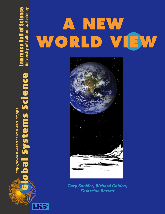
Chapter 5
When thinking of the world as interwoven systems it’s easy to understand that places really remote from us can have rather direct effects on our daily lives.

Most people in the United States don’t think of ecology in Brazil, New Guinea, or Australia as affecting them on a day to day basis. Think again.
The Amazon basin is a vast expanse, more than 2.5 million square miles—an area almost as big as Australia—having the largest rainforest in the world. The Amazon river flows 3,000 miles from the Andes to the sea, longer than any river but the Nile.
Millions of Species
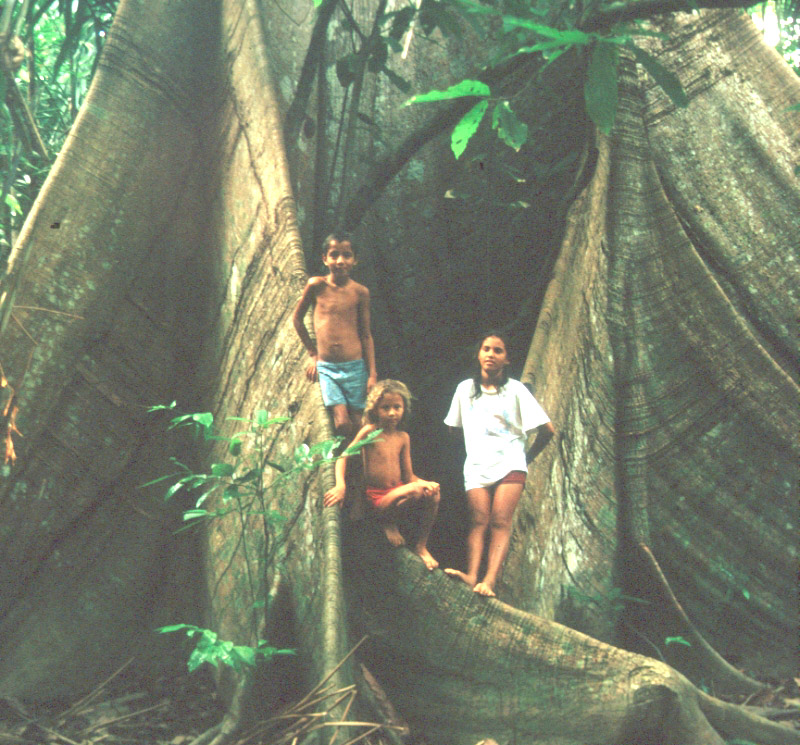
The Amazon River basin has varied types of environments that are home to literally millions of species. Over 1,000 species of butterflies alone have been recorded in the Amazon. It has several million animal species, mostly insects—and 3,000 known species of land vertebrates, as well as one fifth of the world’s bird species in less than 5% of the world’s land surface. About 80% of all known green plants are flowering plants (angiosperms), most of which are found in the tropical rainforests of the world. A small area of tropical rainforest may contain more than 750 types of trees and 1,500 species of higher plants.
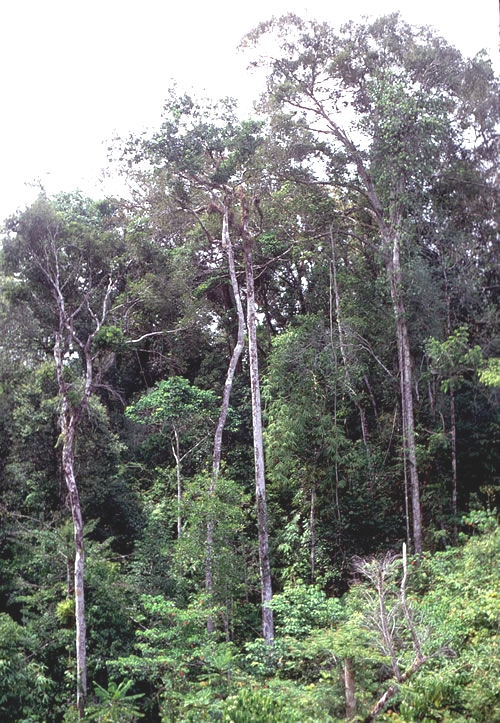
Foods and Medicines
At least 25 percent of all modern drugs originally came from rainforests. Scientists have identified over 2,000 tropical plants with anti-cancer properties. Many foods we consume, including rice, millet, bananas, oranges, pineapples, coffee, and tea, originate in rainforests. Rainforests are source of genetic material crucial to the sustained productivity of many modern crops.
Rainforests and Global Warming
The sheer number of trees in the Amazon basin act as a giant “carbon sink”, with all those trees dutifully capturing carbon dioxide from the atmosphere and converting it to carbon compounds embedded in the trees. Carbon dioxide, which humans produce at a rate of nearly six billion tons per year through burning of fossil fuels (gas, oil, and coal), is a key greenhouse gas, one of several gases that trap heat in the atmosphere, leading to global warming. [See GSS book: Climate Change for more about this topic.] Climate change could lead to a number of unpleasant effects ranging from rising ocean levels to increase in severity of storms and associated property damage. The ability of forests to act as a carbon sink could be one of many critical factors affecting the delicate balance of movement of carbon back and forth between solid compounds and gaseous forms.
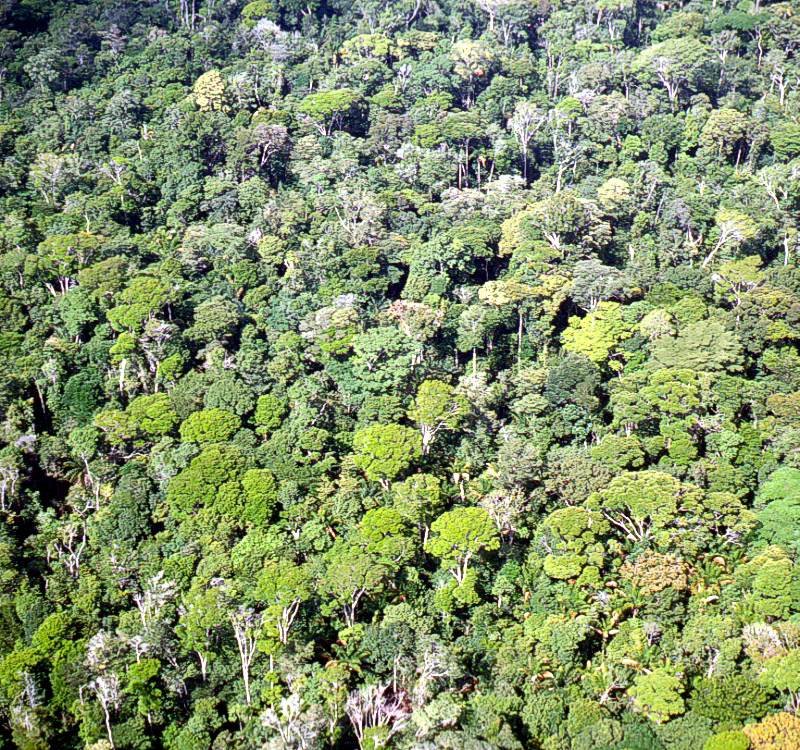
Question 5.1.
Tropical rainforests are steadily disappearing. How do you think the rainforests of the globe are being destroyed? Is it by insects? Drought? Large-scale forest fires? What?
| Types of Rainforests There are basically two types of rainforests, tropical and temperate. Temperate rainforests, like the forests described in previous chapters, are found near the cooler coastal areas relatively far north or south of the equator. Tropical rainforests are found closer to the equator where it is warm. The tropical rainforest is a hot, moist environment (biome) where it rains heavily almost all year long. The Amazon is the wettest large region on Earth, with an average rainfall of 2.54 meters per year. It has dense canopies of vegetation that form three different layers: the top layer is a canopy of giant trees 75 meters tall (about 250 ft) or more; the middle layer, or understory, has vines, smaller trees, ferns, and palms; and the bottom layer, or floor, is covered with wet leaves and leaf litter that decomposes, rapidly sending nutrients back into the soil. |
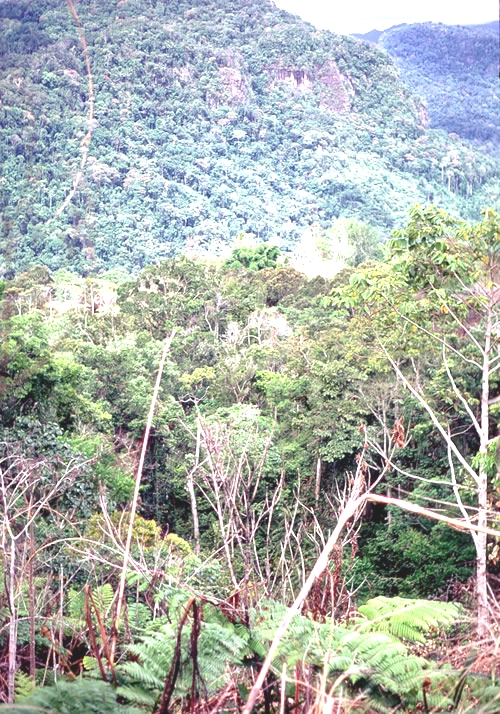

AN5.1. Satellite Views of Rondonia Brazil
Amazon rainforests are disappearing. In this activity, you can use the image analysis software program with satellite images to determine characteristics of forest loss over a number of years.

Analysis of Deforestation in Rondonia
In image analysis software, open the following three satellite images in this order:
Rondonia_1975.jpeg
Rondonia_1986.jpeg
Rondonia_1992.jpeg
Question 5.9.
What is the distance between roads that run west to east on the satellite image?
Question 5.10.
Draw a north-south line across these east-west roads and describe how the vegetation changes along the line. What are the average or mean NDVI (normalized difference vegetation index) values along the line for each of the 3 years? Compare your values to those observed by others in your class.
Question 5.11.
In general, describe how vegetation is changing in this section of Brazilian rainforest from 1975 to 1992. Examine features such as roads and villages and explore how vegetation changes within and near these features. Make a record of details for what you examine, such as:
Tool used?
Coordinates of point, line, or area (box corners) that you select?
(e.g. Corner #1 at x=363 and y=178 and corner #2 at x=378 and y=190).
Length of line or area of box selected.
What surface features appear along the line or in the box in the different images?
What is the mean NDVI value for area selected in each of the three images?
Question 5.12.
What is your projection for the forest ground cover? In this projection, consider how well the NDVI identifies the type of vegetation covering the ground.
Discuss your observations and conclusions with your classmate. Is there agreement among views? Are there conflicting opinions and data?
Be prepared to present your findings and conclusions to the class.
What additional data would help complete any questions you still have about deforestation in this area of Brazil?
I. Competing Land Use Interests in the Rainforest
Adapted from: The Mandala Projects (American University, Washington DC);
Trade and Environment Database (TED) Case Studies
Brazilian Rubber and Environment—CASE NUMBER: 312
Some of the trees in the rainforest are rubber trees. The system of extracting rubber in this region was not one of plantation farming (cutting/harvesting) of the rubber trees, but rather rubber tapping in which slashes are cut into the tree and the sap is allowed to drain into a receptacle.
The history of rubber tappers in Brazil has not been a particularly pleasant one. During the Second World War the demand for rubber increased to meet the demand of the United States military. The rubber plantations of Malaysia had been taken control of by the Japanese and concern in the U. S. was for a stable supply of rub- ber necessary for a war machine at this time in history
In the 1980s, Chico Mendes was the leader and political organizer of The National Council of Rubber Tappers, the union of the rubber tappers. Mendes tried to look out for the interests of rubber tappers: the trees. Without the rainforest there is no livelihood for them.
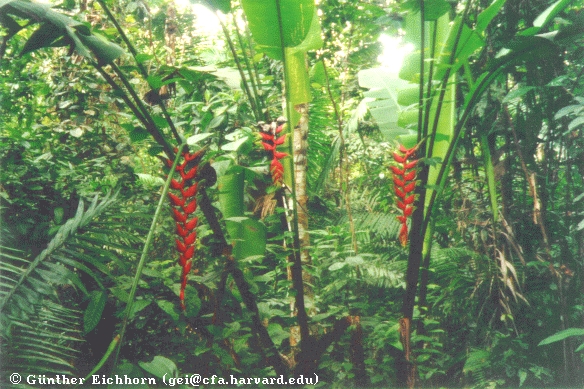
Photo by Gunther Eichhorn
As large land owners, seeking profit, clear cut the forest to make pasture lands for cattle, Chico Mendes saw his means of living going up in smoke. The National Council of Rubber Tappers started non-violent resistance. When a crew of workers came to clear cut an area of the Amazon, a group of rubber tappers would surround them and not allow them to move until they turned over their chainsaws and other tools. These same chainsaws were then used to tear down the camps that had been set up.
Ultimately the struggle led to a system of land use called an “extractive reserve” which set aside land for common use by people to take out products—not just rubber, but other things such as palm hearts and brazil nuts, without destroying the forest. The system supports the social well-being of the rainforest inhabitants, and the long-term sustainability of trade in forest products. But there are still great tensions between the cattle ranchers, settlers, loggers and the rubber tappers.
Chico Mendes was shot and killed on December 22, 1988, presumably by a cattle rancher who wanted to protect his right to clear the rainforest. Darli Alves da Silva and his son, Darci, were convicted in December 1990 for the killing of Mendes. The effect was to make a martyr. International attention increased enormously. Even Hollywood got in on the scene to make a movie about Mendes’s life. Books were published telling his story. The World Bank and the Inter-American Development Bank became more concerned with the environmental impact of development. The events surrounding the life of Chico Mendes are seen as an environmental success story as well as a victory for social justice and dignity of the rural worker in Brazil.
Yet in the years since the murder, ranchers and others have continued to clear the area in large swaths. In 1995, Brazil’s National Institute for Space Research, which tracks the burning of the rainforest, detected four times as many fires as it did in 1994. Dozens of rubber tappers and rain-forest activists allegedly have been abused, threatened and killed for speaking out against the special interests. Few arrests have been made in connection with those allegations.
II. Interview with an Amazon Forest Research Scientist

Dr. Nelson Dias is a Research Scientist at University of Taubat (Unitau), Taubat, SP, Brazil. Global Systems Science collaborator, Dr. Paul Mausel, Professor of Geography at Indiana State University, works with Dr. Dias and conducted the following interview March 10, 2004.
PM: Approximately 15% of the Amazon Basin has been deforested. What are the major causes of this deforestation?
ND: New land is needed to support the population of the Amazon region that has grown from six million to twenty million people in the past 24 years. Agricultural, forest, and mineral extraction opportunities have greatly increased the past 30 years through road building, government support of settlers by providing free or low cost land, and other economic incentives. These actions have helped to make rapid population growth possible in the Amazon.
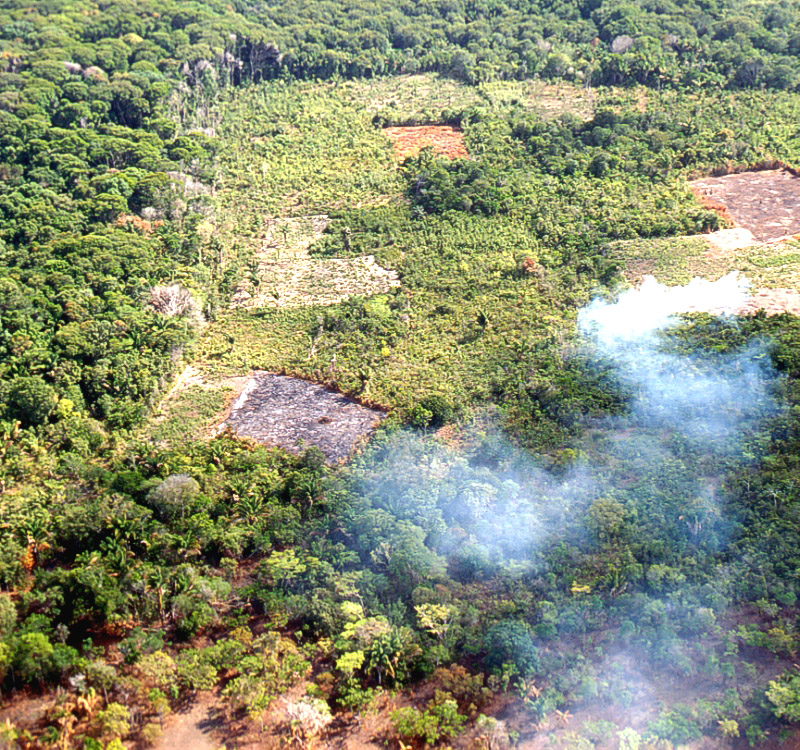
PM: What is the current rate of deforestation and what are some of the consequences of this deforestation?
ND: Currently, 15,000-20,000 sq. km of mature forest are being cut/burned in the Amazon each year (.4% – .5%/year of the total forest resource). Actual and potential consequences of excessive deforestation include:
- loss of plant and animal biodiversity
- increase the amount of carbon dioxide in the air that is thought to contribute to global warming whose consequences include sea level rise and major climatic changes in the world; and
- soil erosion and soil nutrient and organic matter depletion; and
- decreasing precipitation and increasing temperature in large severely deforested areas.
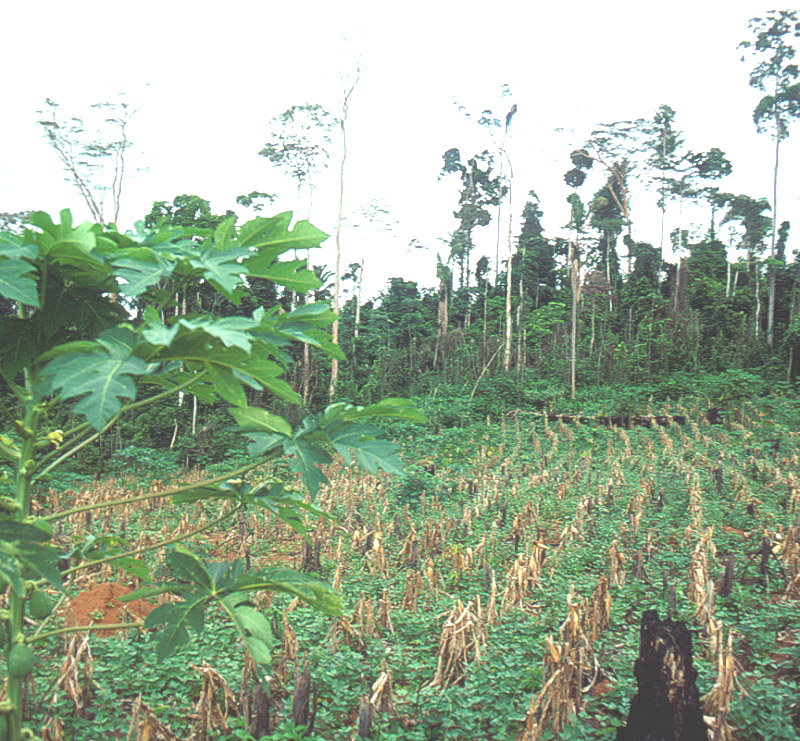
PM: What happens to the land after deforestation?
ND: The are numerous possibilities, but one of the most common sequences of land use after deforestation is crop to pasture to initial forest succession (small trees mixed with some grass) to more advanced succession (full forest, but not as tall or diverse as the original forest), then back to mature or near mature forest. This full sequence of land use may be interrupted or have elements missing (e.g. crop to pasture to initial succession back to crop). In poor soil areas, a deforested mature forest may never return to its original state, but in good soil areas, a mature or near mature forests can develop in 50 years or so if left undisturbed after deforestation.
PM: Will all the original forests of the Amazon disappear?
ND: Possibly, except for national parks, state parks, and other relatively small and protected areas. However, scientists from all over the world are conducting research that provides information and techniques that, if employed properly, have the potential to help create a sustainable land use whereby both vital economic growth and protection of most environmental elements can co-exist. This is a goal of many, but to what degree it will be achieved is uncertain.

PM: What are some of the characteristics of land use sustainability that permits reasonable economic uses and environmental needs of the land to co-exist?
ND: Sustainability means different things to different people, but many scientists and environmental planners have suggested that some of the elements associated with sustainability are that
- ideally, lands with poor soils or high slope or excessive wetness should remain in forest, possibly with some agroforestry (trees bearing fruit or some other commercially valuable product) or managed forests (selective cutting of trees of high commercial value for their wood);
- flatter lands with average or good soils should focus most on crops, pasture, managed forests, and agroforestry using methods that protect the soil; and
- corridors of forests should be interspersed among areas devoted to crops and pasture to support plant and animal species (biodiversity), as well as to protect the environment from major soil erosion and undesirable consequences of microclimatic changes induced by deforestation (reducing local precipitation and increasing local temperature).
III. Summary of Rainforest Issues
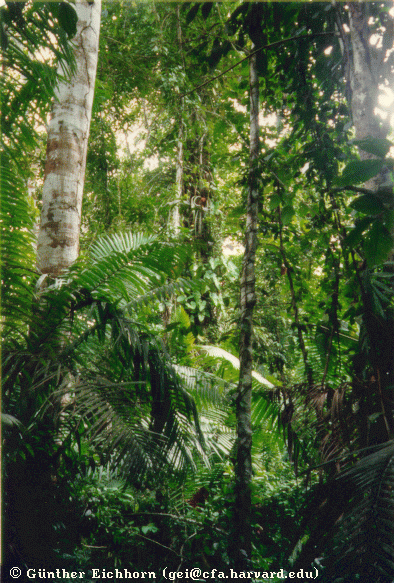
Deforestation in the Amazon Basin is caused by human activities such as agriculture, cattle ranching, logging and local demand for fuelwood. Trade may also play an important role both in destroying the rainforests and possibly saving them. The United States and Europe are the largest importers of rainforest products (wood, nuts, rubber, …). Though deforestation is the major problem, other related problems include:
(a) Global Warming: Deforestation in developing countries accounts for between 7 and 31 percent of global carbon dioxide emissions which cause climate change.
(b) Indigenous Tribes: There were hundreds different types of indigenous tribes in the Amazon. Between 1900 and 1957 about eighty tribes had been destroyed and the number of indigenous peoples dropped from one million to two hundred thousand. The Amazon basin held most of the remaining tribes (some 140 tribes). These too could become extinct if their land is taken away.
(c) Bio-diversity: Northern Brazil is losing natural forests with the substitution of fast-growing eucalyptus and pine trees, cattle ranching and commercial logging.
(d) Species Loss: Much of Brazil’s native flora, fauna and animal species are being lost with the harvesting of tropical forests. Globally, forests cover about 7 percent of the planet’s land surface, but they are home to 50 percent of the plants and animals found on Earth. As many as 27,000 species may go extinct every year. These extinctions have philosophical, spiritual, cultural, scientific and economic impacts. Because Brazil has the highest species diversity on the Earth, it is an epicenter of efforts to control deforestation.
The theory behind sustainable rainforest harvest is that forests are of more value when left standing than when they are felled. This value can be expressed in the commercial value of forest products (e.g. fruits, nuts, and cosmetic oils). A study done on the value of the fruits, latex, medicinal herbs, essences and oil discovered that in the long run investment in these products were more profitable than either logging or cattle ranching.
Certain products such as Brazil nuts are now being marketed supposedly as a way to save the rainforest and to protect indigenous populations. However, most of these products are commercialized, often by unscrupulous dealers. Consequently, even when indigenous peoples are directly involved in the transactions, they become victims of economic forces. Perhaps support for indigenous peoples should not rely so much on purchasing forest products, as respecting their rights in fair trade practice.

